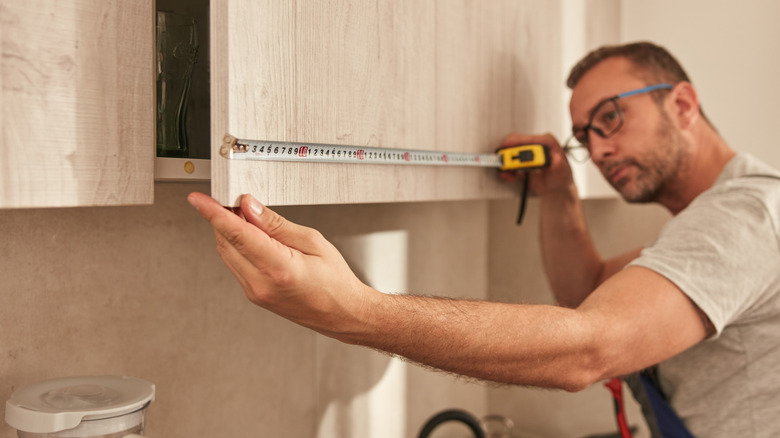How To Properly Measure Kitchen Appliances So You Don't Buy The Wrong Size
Measuring space for appliances seems simple — after all, you passed second grade and know how to use a ruler. But plenty of shoppers have been burned by their overconfidence. Even a fraction of an inch can make a big difference. It's easy to forget about hinges or overlook seemingly small lips and ledges. You should always take all your measurements before you buy your appliance. It seems obvious — until you get caught up in the excitement of a limited-time sale.
First and foremost, you've got to make sure you can actually get your new appliance to the kitchen. All your careful measurements will be for naught if you can't fit the appliance through the door. Write down the width of doors, measure the distance around corners, and make sure you have ceiling space if you need to lug a bulky fridge upstairs. Remember to add a couple of inches for clearance, and include moulding and baseboards.
After you've measured your space, start shopping with those dimensions in mind. If you're shopping online, you can often filter your results based on dimensions — but don't rely on the first measurements you see. Exact dimensions can vary, even among appliances from the same brand. Download the manual to see whether these measurements include handles and hinges. Check the manufacturer's recommendations for clearance, too. Proper ventilation keeps you safe and your appliance running smoothly. Make sure you have the room you need for any gas lines, vents, or outlets required.
Measure for size and functionality, then measure again
Don't measure width, depth, and height just once and be done with it. For one, your space may not be a perfect rectangle. It's normal to have slight variations, so measure every side and use the smallest measurement to ensure your appliance fits. Some appliances account for things like crooked floors. Many ranges have adjustable feet so your stove can be level even if your floor isn't. Once you're done, check your measurements again. If you're checking spaces for built-in appliances — like cooktops — you'll want to measure the existing appliance, remove it, and measure the cutout. Cutouts are usually smaller than the appliance itself, so check the manufacturer's dimensions for both the cutout and the overhang.
Struggling to measure the back wall of a cabinet with a bulky measuring tape? Avoid bending the tape — it won't give you an accurate measurement. The best way to measure is to place the end of the tape against one wall of the cabinet and press the back of the case against the other wall. Then record the measurement and add the length of the case. Most measuring tapes will have the width printed on the side.
That specific math can be tricky if it's been years since you added fractions. For an easier method, measure off 10 inches from one side, then measure to that point from the other. Add 10 inches, and you'll have an accurate number.
Plan for comfort, safety, and usability
You should also take into account special cases. There might be one drawer in your refrigerator that the manufacturer designed to be removable. However, the contractor who designed the kitchen may not have taken that into consideration. If the refrigerator is flush against a wall, it can't open all the way. It doesn't affect day-to-day fridge use, but it's a pain when it's time for a deep clean, and that drawer needs to be removed. Appliances aren't limited to the size of the box they come in. Consider how the space around the appliance will be used. Make sure you have room to open doors; this way, you can safely remove food from a 400-degree oven or unload freshly washed dishes from the dishwasher.
There is no perfect, one-size-fits-all kitchen layout. Placing your microwave above eye level will make it tricky to handle hot foods, but eye level varies from person to person. A lower placement isn't always ideal, though, especially if you have young kids. Prioritize ventilation if you love fried foods, and consider an oven-centric design with an emphasis on counter space if you're a big baker.
Finally, remember that there's no shame in hiring a professional if you're feeling overwhelmed. Depending on where you buy your appliances, you may be able to get installation for free. It might be worthwhile to get a consultation from a contractor, too. As for your old equipment, look for appliance recycling services or check to see if your retailer has a buy-back program.


